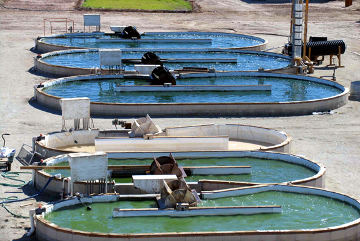Calling someone 'pond scum' may soon be a compliment

San Diego is the world leader of research into creating petroleum-based products from algae (AKA pond scum.) The potential is certainly there. All it takes to create algae for biofuel is lots of sun, level ground, and a little water. It is best grown in deserts, and the nearby Imperial Valley is an ideal location.
Algae genetic engineer Dr. Stephen Mayfield explains that petroleum is simply algae that is 200-300 million years old. So it behooves us to create our own algae now, as the oil extracted from it can be converted directly into gasoline at a refinery. Indeed, the US Navy plans to run half its fleet on alternative fuel within 10 years. Much of that could well be biofuel from algae.
Dr. Mayfield helped found the San Diego Center for Algae Biotechnology, which develops therapeutic proteins (some of which can sell for thousands of dollars a gram) as well as researches and develops strains of algae for biofuel. Thus, commercial partners who are not specifically interested in biofuel can get involved too, as apparently ever-adaptable algae can also be used in polymers, animal feed, industrial enzymes, and more. SD-CAB has also received several million in grants from the Department of Energy and the State of California for research and to train workers in this fast-growing field.
Algae biofuel has major advantages over other types of biofuel. Growing corn or jatropha specifically to be used as feedstock for biofuel processing uses large amounts of water and fertilizer. It raises food prices by using land formerly used for food crops. Plus, the feedstock often has to be trucked long distances to the processing plant. However, in some types of cellulosic ethanol, the feedstock is waste from wood, agricultural processing, and animal processing, and the biofuel processing plant is located onsite. This approach clearly makes sense, but it can't scale past the size of the processing facility. Algae biofuel has no such limitations.
Algae can produce about 5,000 gallons (120 barrels) per acre per year, says Mayfield. It has multiple growing seasons and grows much faster than corn. While that number may seem low, it is vastly higher than corn or beets, which produce just 439-552 gallons of ethanol per acre.
Mayfield believes that the price of oil will be soaring soon enough so now is the time to find alternatives and to do it on a commercial scale. Yes, we're talking about gene twiddling. But do we have any choice? And is gene engineering necessarily bad. After all he says, "There are zero native strains in any industrial food application." Everyone has been cross-bred and tweaked. "Because the minute you've gone out to select a better strain, you've modified the genome."
If algae biofuel can be done at a commercial scale for a reasonable price, it will change the planet. Such breakthroughs may well come out of San Diego



